
|
|
Für die deutsche Fassung bitte nach unten scrollen
|
|
|
|
Faces of the Past
|
Her almond-shaped eyes radiate above the high cheekbones. Her smile has enchanted observers for over 2,500 years. The wonderful archaic terracotta head of a goddess is doubtless one of most beautiful ancient faces we currently have in our programme. Whereby: The Egyptian royal also gifts us with a smile – already for over 3,000 years. The fragment of a granite relief depicts a Ramesside noble full of pride and grace. But faces of antiquity have many facets. This is shown by the bird-headed Hittite nail idol and above all the Caucasian idol of an adorant. The latter looks at us with wide eyes and raises his huge hands. What we might perceive today as a humouros gesture once stood for deep reverence for the gods.
|
24 March – Save the Date. In March it's finally that time again: We are delighted to invite you to our first big exhibtion opening of the year on March 24 at 6 p.m. Under the title "Animal Depictions from Four Millennia" we show artworks of museum-quality. This invitation shows what they look like. It will of course also be in the mail in paper form in the next few days. Enjoy with us an evening with wine and marvel at animal depictions full of power, archaism, but also divine gentleness. We are looking forward to your visit!
|
|
|
|
Our Highlight of the Month:
|
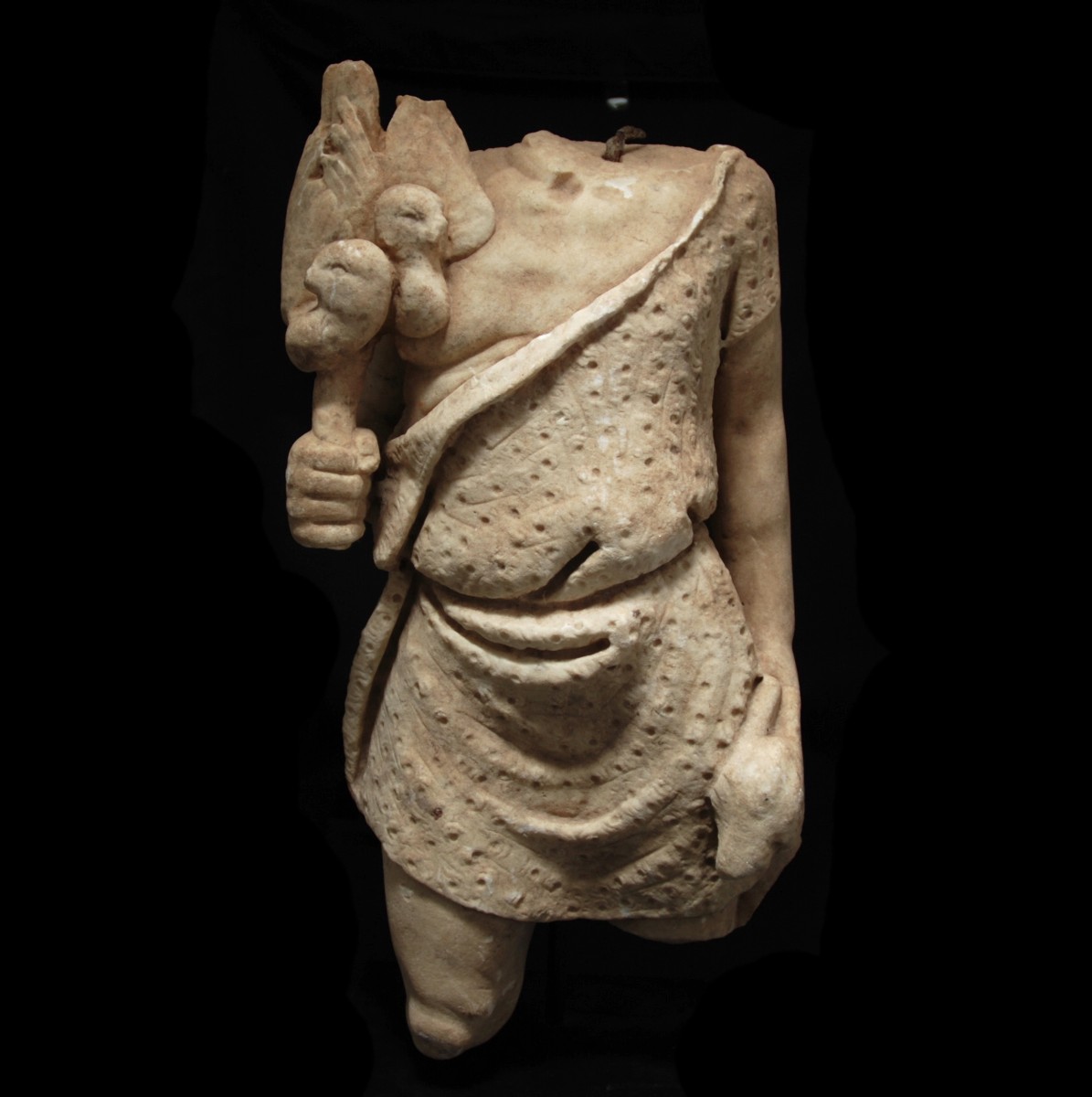
|
|
|
|
|
|
|
|
Roman Empire – 2nd century A.D.
|
High-quality torso of a strong, male figure who wears a dotted panther fur. The fur is tied around the belly and held on the left shoulder, where the head of the animals lies. The man, interpreted as a Satyr, holds in his right hand on waist level a spear with two birds, possibly ducks. The left arm is parallel to the body, he holds in his hand a hunted animal on its legs, possibly a rabbit. The muscles and the bone structure are worked out in detail. A coessential torso, which very likely is from the same workshop and the same sculptural group, is in the Barnes Foundation in Philadelphia, USA, with the Accession Number A231. The Barnes torso with the same dotted panther fur holds a wineskin in the arm and is also interpreted as a Satyr. It can therefore be assumed that both statues belonged to a sculptural group that went to the Dionysian festival with wine and delicacies. Mounted.
|
Provenance: Belgian private collection U.C., acquired in the 1950s. Since then in a diplomatic family estate.
Dimensions: 46.5 cm high
Price: 28 000 Euro
|
|
|
|
Selected Artworks of the Month:
|
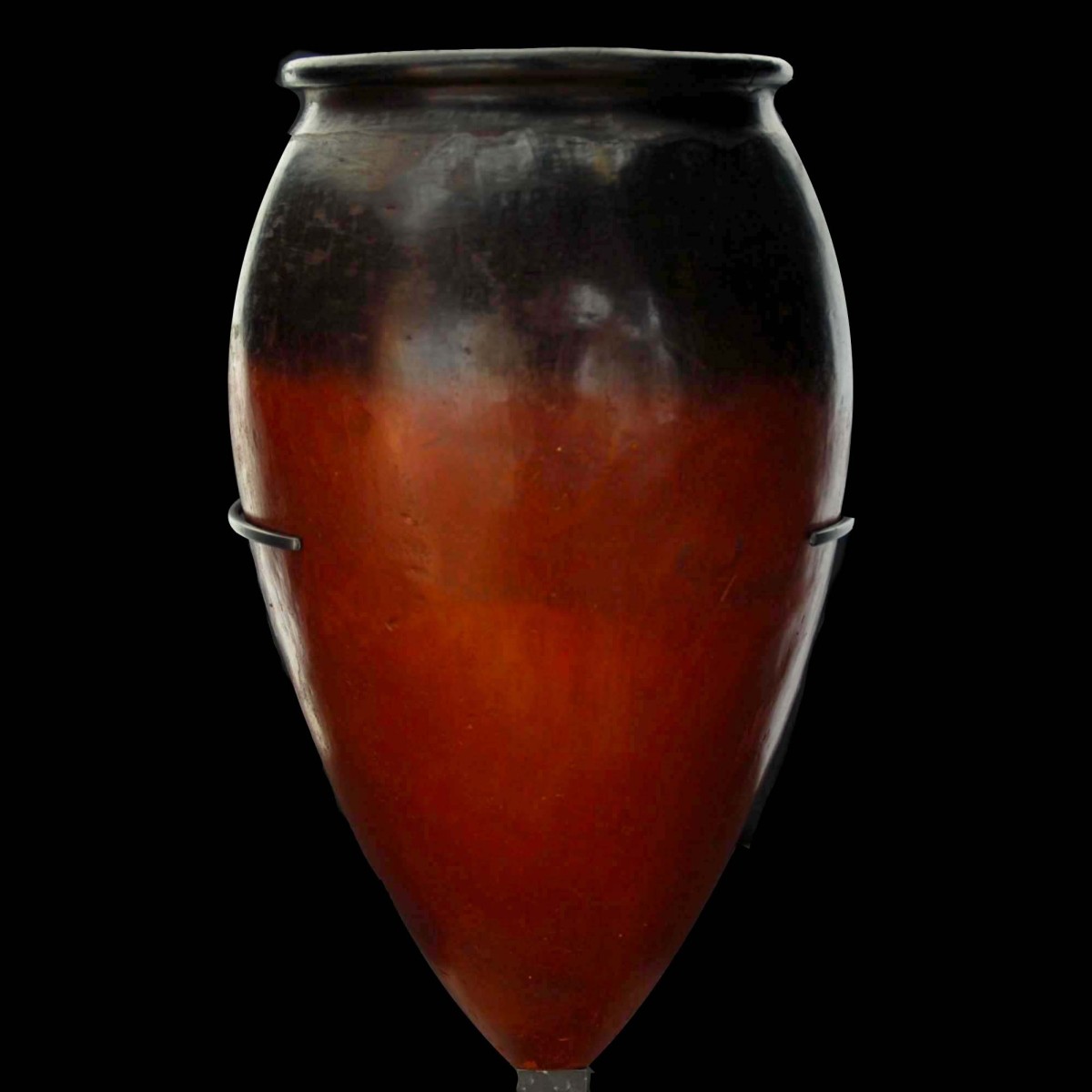
|
|
Egypt – Naqada II Culture, 3500-3200 B.C.
|
Exceptionally large, very elegant vase of the so-called blacktop ware. The ovoid, hand-formed corpus tapering towards the flat base. The rim is rounded and pulled outside. The clay was covered with a red iron oxide, which developed the distinctive dark red color after burning. The black rim resulted after burning the vase, when the upper part is exposed to the thick smoke. See for the type with the rounded, everted rim and the convex form the vase with the nearly same size in the British Museum with the Registration Number 1926,0728.6. Mounted.
|
Provenance: French private collection Haumont, acquired between 1980 and 2008. Sold on 14 July 2017 with Drouot Paris. Last on the English art market. With a French antiquities pass.
Dimensions: 35 cm high
Price: 12 000 Euro
|
|
|
|
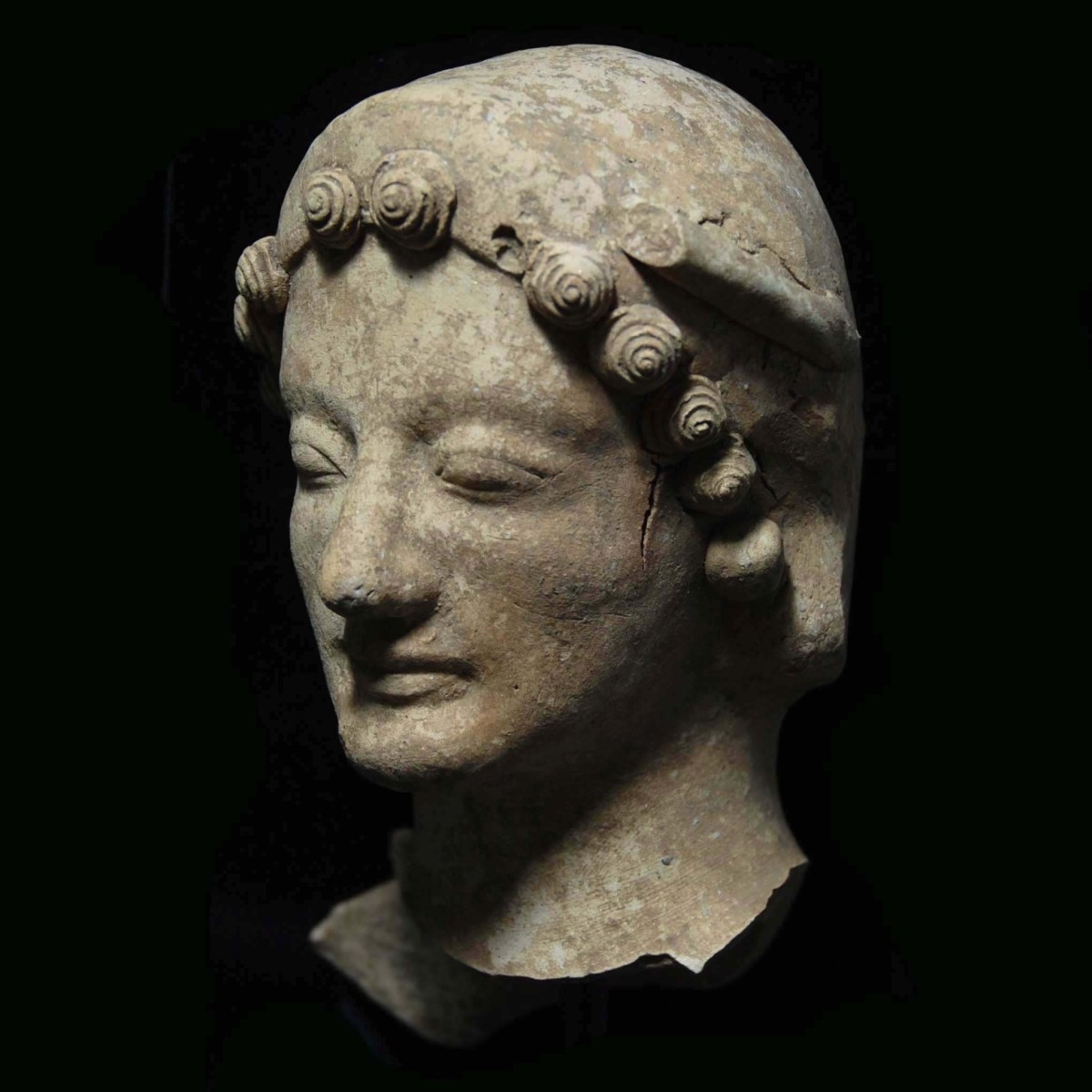
|
|
|
|
|
Exceedingly graceful terracotta head of a goddess dating to the late archaic period. The oval face with high check bones, straight nose, almond-shaped eyes and the characteristic smile. The ears are adorned with circular earrings (one missing). She wears a filet, which is only fragmentarily preserved, the face is framed by corkscrew curls. The neck and right tip of the shoulder are still preserved. On the base a label with the collection number and a sticker with the inscription: "Greek Terracotta head of a Goddess". Mounted.
|
Provenance: New York private collection. Thence auctioned with Sotheby’s New York on 11 December 2002, lot 77. Last in the US private collection Dr. E. B.
Dimensions: 18 cm high
Price: 8 000 Euro
|
|
|
|
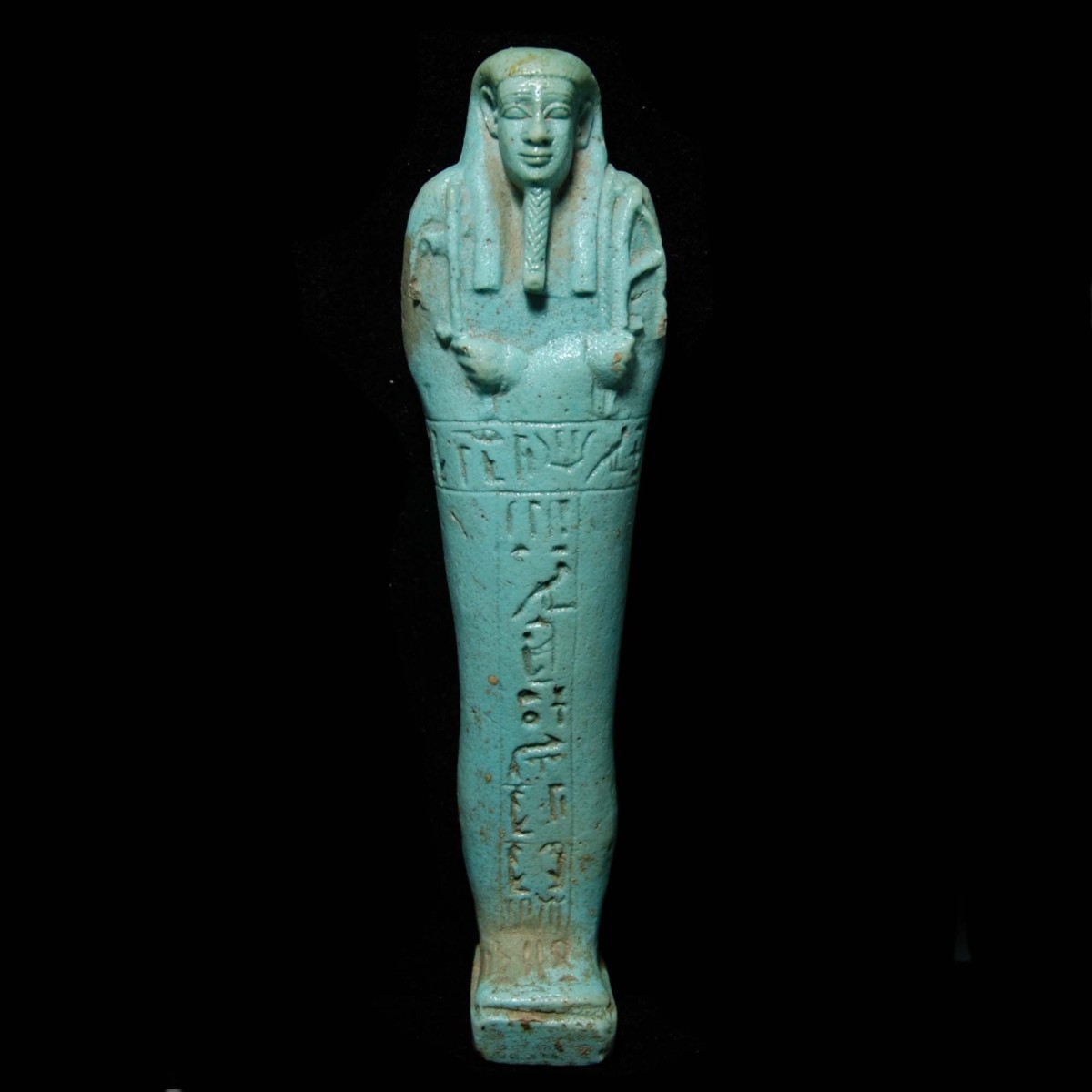
|
|
|
|
|
|
Egypt – Late period, 30th dynasty, 380-342 B.C.
|
Very finely worked out shabti from the tomb of the priest Nesbanebdjed, which was discovered in 1902. The mummiform figure of light blue faience with the arms crossed in front of the chest. In the left hand he holds the hoe, in the right hand the hand plow and the braided cord for the seed bag on the back. The shabti stands on a trapezoidal plinth and leans on a back pillar. The details of the face are finely worked out, the ears protrude from under the tripartite wig, the false beard is long and braided, the end slightly curled. Below the crossed arms the T-shaped hieroglyphic inscription sets in. The translation reads: "Nesbanebdjed, born to Shentyt, the ‘imy-khenty’ priest, the one who divides the two gods, the priest of Osiris in the Apet temple, the scribe of divinity, the overseer over the Wab priests of Sekhmet in Hat-mehit (Mendes), the priest of Banebdjed." In the tomb of Nesbanebjed 322 shabtis like this one with T-shaped inscription were found. Most of the shabtis remained in Egypt. The other ones are in private collections and museums. See for references the shabti in the Metropolitan Museum of Art in New York with the Accession Number 2021.41126, or the one at Sotheby’s auction on 10 December 2008, lot 4. For literature about the shabtis of Nesbanebdjed see J. F. Aubert and L. Aubert, "Statuettes égyptiennes, Chaouabtis, Ouchebtis", Paris, 1974, p. 125, "Reflets du divin: Antiquités pharaoniques et classiques d'une collection privée", Geneva, 2001, No. 73c, as well as G. Janes, "Shabtis: A Private View", Paris, 2002, No. 96. Mounted.
|
Provenance: Swiss private collection, acquired in the 1980s from Galerie Faustus in Geneva.
Dimensions: 16.3 cm high
Price: 8 000 Euro
|
|
|
|
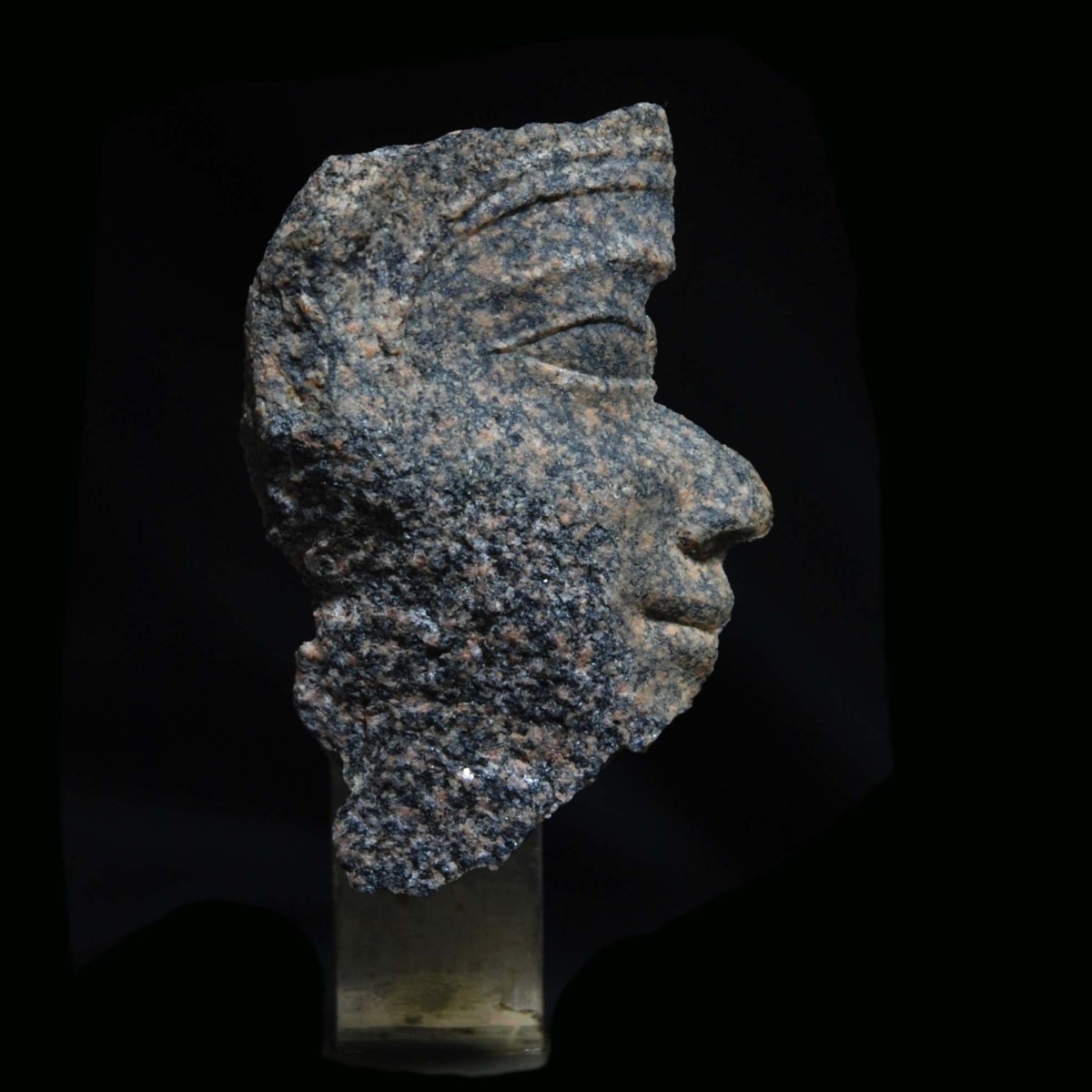
|
|
Egypt – New Kingdom, 19th dynasty, 1292-1189 B.C.
|
Finely worked out relief head with the face of a man to the right. The eyes with finely drawn lids and a short lid line. The mouth formed to a gentle smile. Over the brows parts of the crown or wig are recognizable, which indicate the man as a member of the royal family. Possibly from a door lintel from a sanctuary from the Ramesside period. Mounted on a metal base.
|
Provenance: Collection Carl Tautenhahn, Houston, USA. Acquired prior to 1982.
Dimensions: 9.3 cm high
Price: 4 000 Euro
|
|
|
|
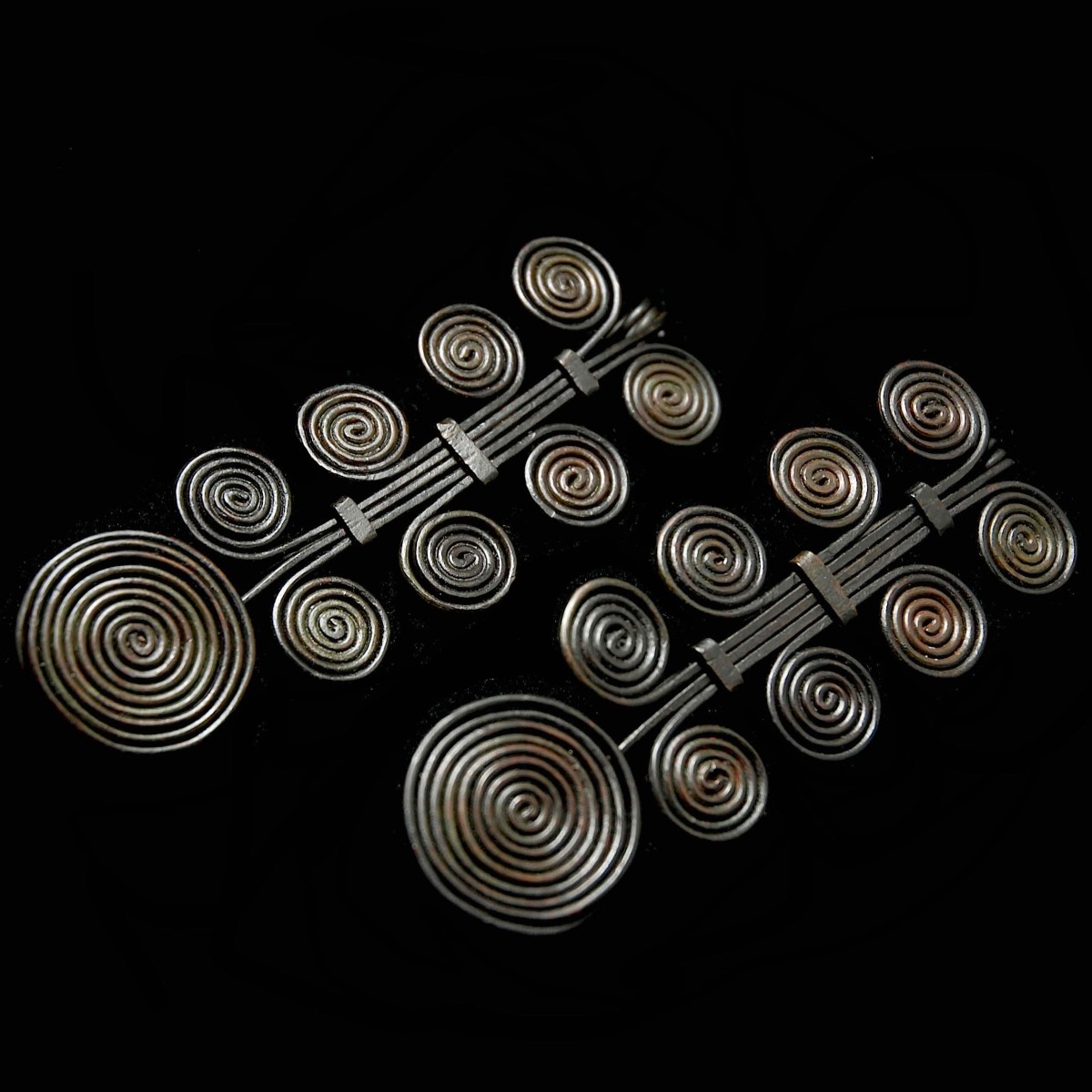
|
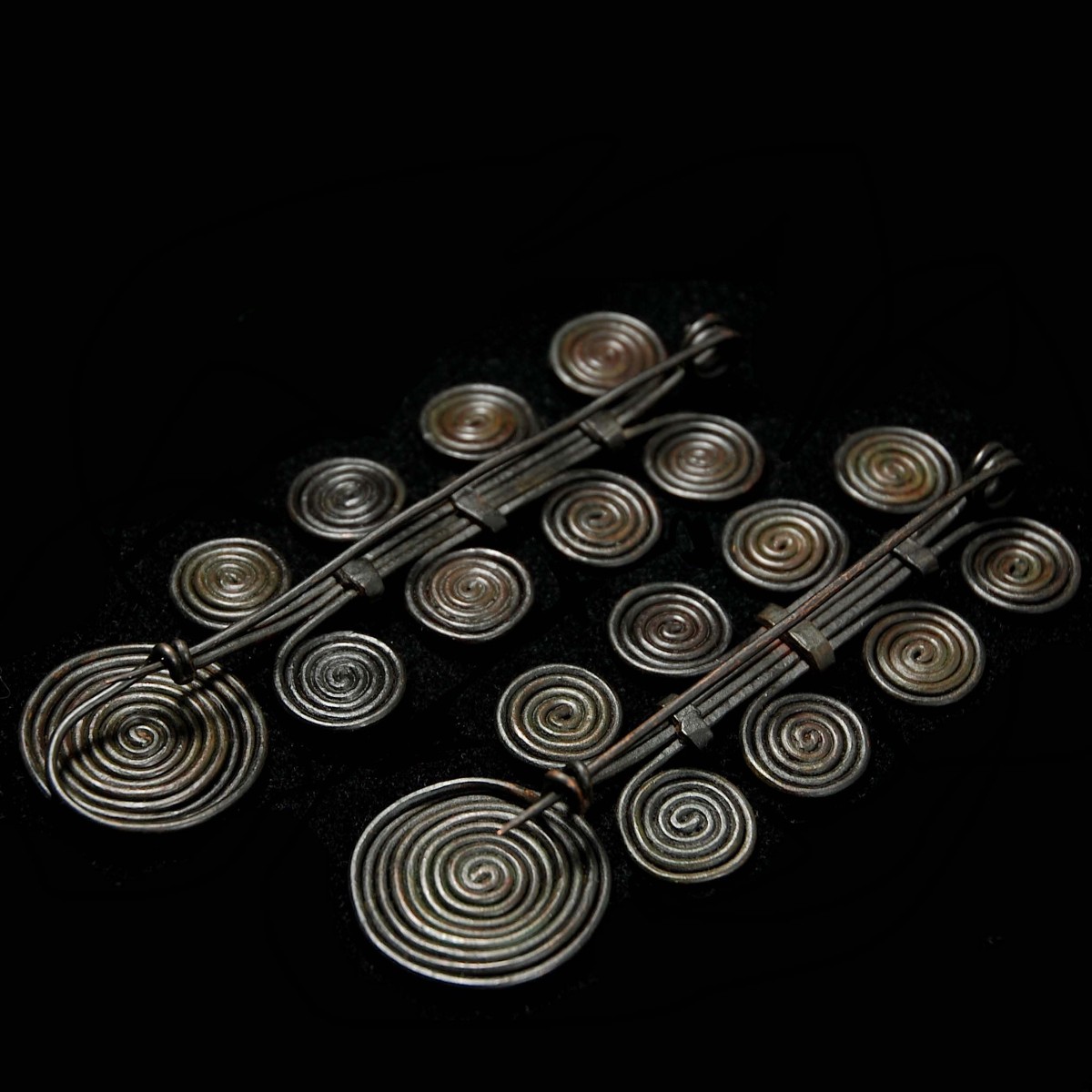
|
|
Middle Europe – Hallstatt B-period, 1000-800 B.C.
|
A matching pair of elaborately worked out Bronze Age brooches or Posamenterie fibulas each with eight small and one large end spiral. Middle clamp, end spiral and loop-shaped needle holder, as well as the needle on the back are formed from one single bronze wire. Two parallel wires are attached on each side of the middle clamp, fixed with three collars. These wires are twirled into four spirals on each side. This type of Bronze Age jewellery was found in the areas of today’s Hungary, Slovakia and the Czech Republic. With beautiful black-green patina.
|
Provenance: Collection Axel Guttmann (1944-2011). Thence US private collection Tom Barnett. Last in the Rack collection in Germany.
Dimensions: 12.1 cm and 12.4 cm long respectively
Price: 4 800 Euro
|
|
|
|
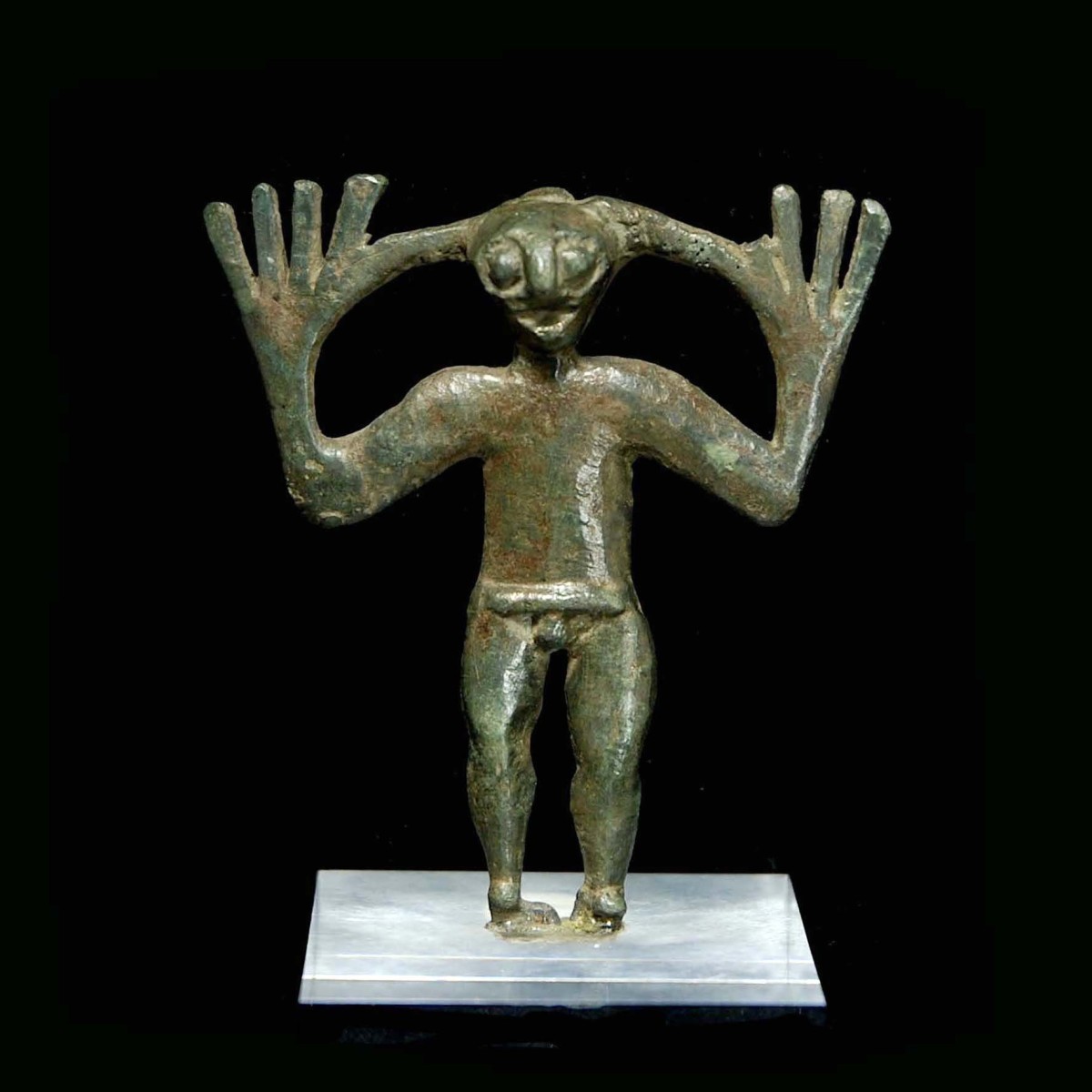
|
|
|
|
|
|
Northern Caucasus – 1st half of 1st millennium B.C.
|
Flat bronze idol of a stylized man in adoration gesture. The unclothed figure stands straight with slightly spread legs and almost square raised arms with oversized hands. The hands with five fingers in form of large prongs, the stretched-out thumbs touching the head. The face with large, bulging, round eyes, prominent nose and deeply notched mouth. The upper body and the arms are flat, however, legs, head and private part are sculpturally accentuated. Votive figures such as the present one were found in Northern Caucasia, for example in Karata in Dagestan. They were possibly made as offerings to the gods close to sacrificial places, sold and offered to the gods. See for the type: “Archäologie und Volkskunst aus Dagestan: Völker zwischen Kaukasus und Kaspischem Meer: Katalog zur Ausstellung im Tiroler Volkskunstmuseum und im Vorarlberger Landesmuseum, 12. August bis 7. November 1999, 12. Februar bis 9. April 2000”, numbers 50 and 51, page 58. Mounted.
|
Provenance: Collection Dr. Wassilijew, 1980s. Thence Antikenkabinett Gackstätter with the inventory number 02808. Published on the Christmas card of the Antikenkabinett Gackstätter early 2000. Since 2005 in a Munich collection. With an original certificate of the Antikenkabinett Gackstätter and the Christmas card.
Dimensions: 6.3 cm high
Price: 4 800 Euro
|
|
|
|
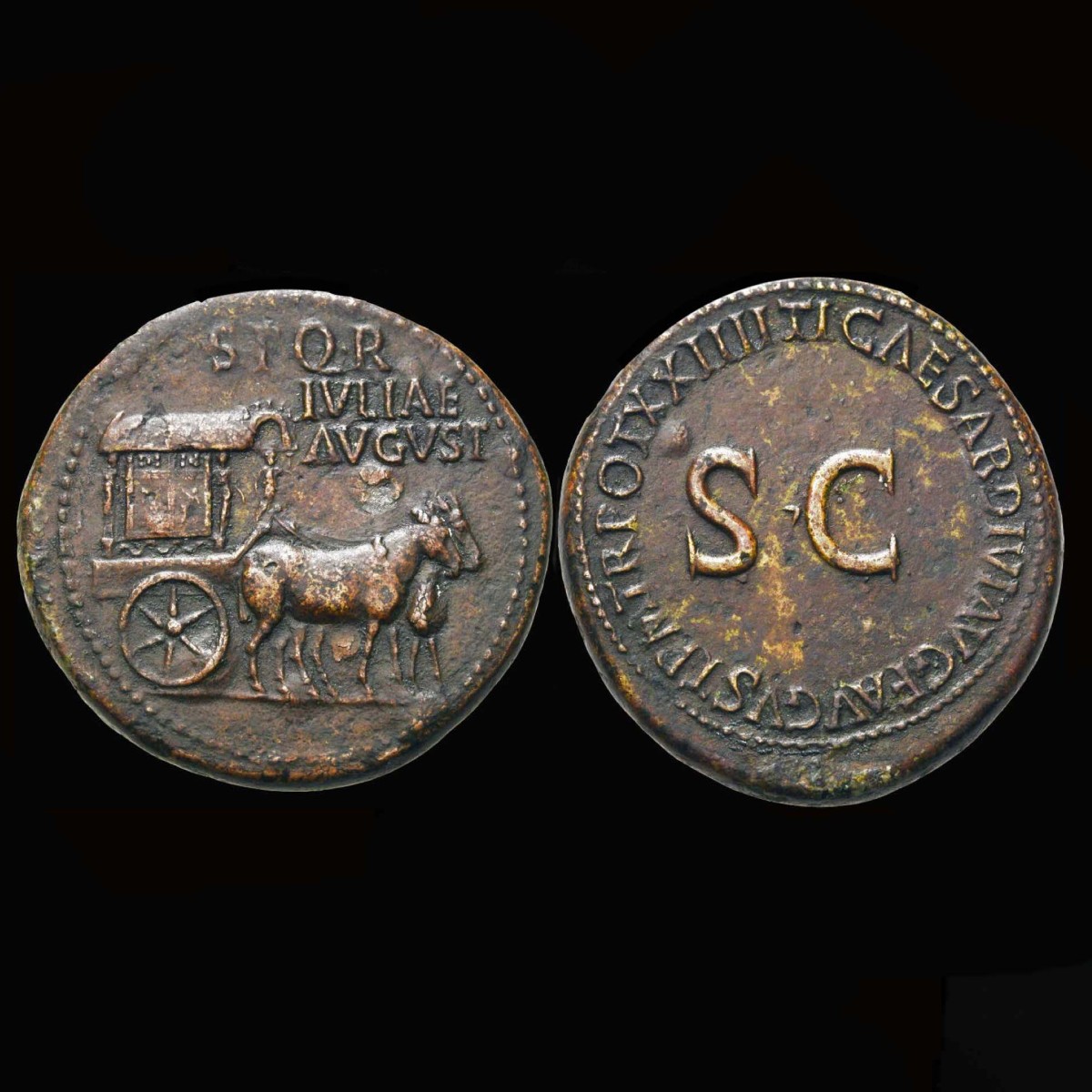
|
|
Roman Empire – 22-23 A.D.
|
Magnificient bronze sestertius of Empress Livia, struck under the reign of her son Tiberius in the mint Rome. On the obverse the inscription: S P Q R/IVLIAE AUGUST. The image depicts a decorated carpentum (the roofed, two-wheeled Roman chariot), which was allowed within the city of Rome only to a few, high-ranking ladies, who mostly were members of the royal family. Two mules are harnessed in front of the carriage. On the reverse SC for Senatus Consulto (by the decree of the Senate), as well as encircling TI CAESAR DIVI AVG F AVGVUST P M TR POT XXIIII (for: Tiberius Caesar Divi Augusti Filius Augustus, Pontifex Maximus, Tribunicia Potestate Vicesima Quarta).
|
Provenance: Auction Conand Hotel d’Ainay, Lyon on 27. September 2018, lot 52. Prior in a French private collection from the 1960s to 1970s.
Dimensions: 3.6 cm in diameter; 27.45 grams
Price: 3 200 Euro
|
|
|
|
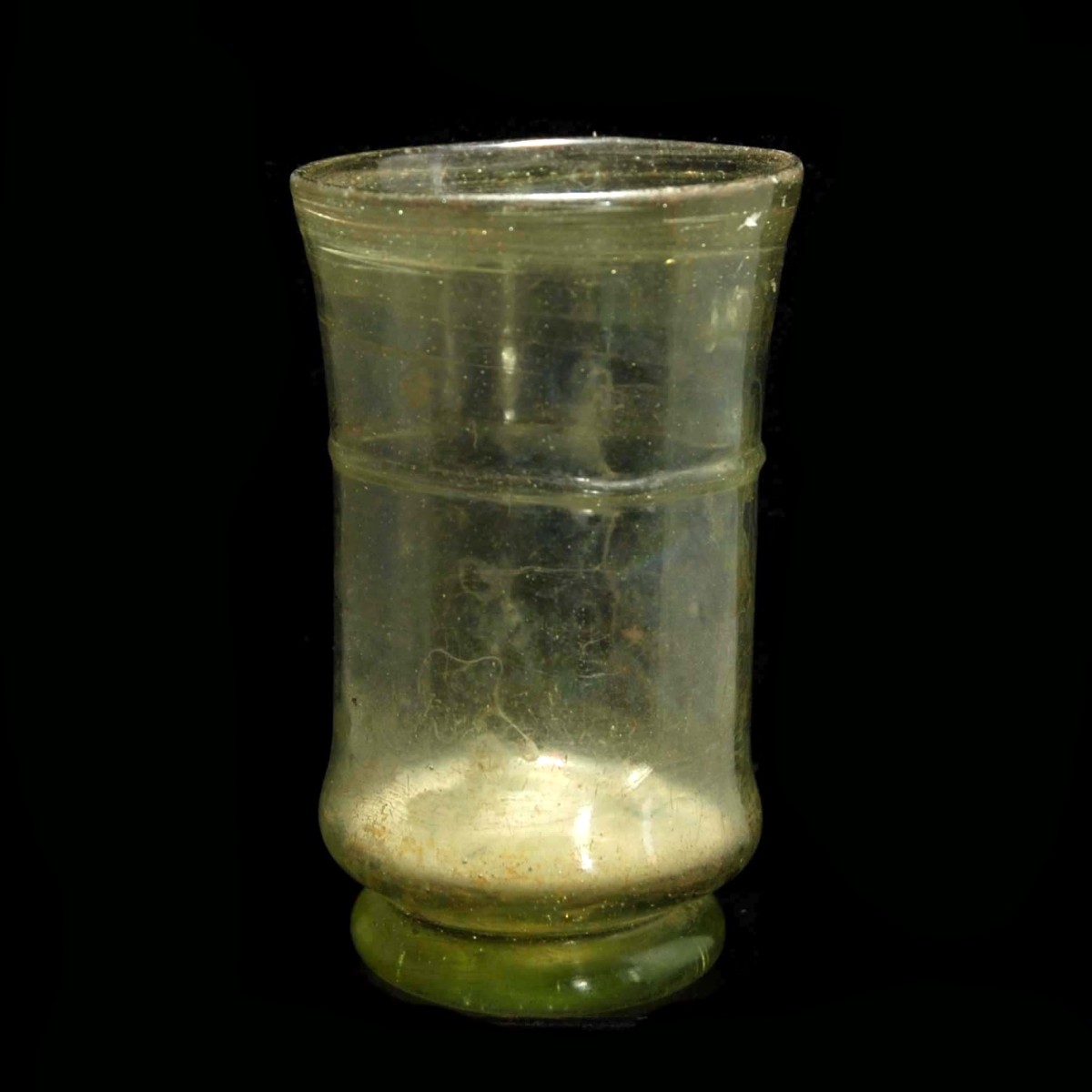
|
|
|
|
Roman Empire – 4th century A.D.
|
Roman beaker of transparent, discolored glass. The corpus with a cylindrical, slightly concave wall. The flat base with a rib, pulled out from the wall and massive. On the upper part of the beaker an encircling applied thread. See for the type “Römisches, byzantinisches und frühmittelalterliches Glas – Sammlung Ernesto Wolf”, Hatje Cantz 2001, number 109. From Palastine.
|
Provenance: From the inventory of the judicially dissolved Parisian gallery La Reine Margot. There listed with the inventory number 3791B.
Dimensions: 10.5 cm high
Price: 1.200 Euro
|
|
|
|
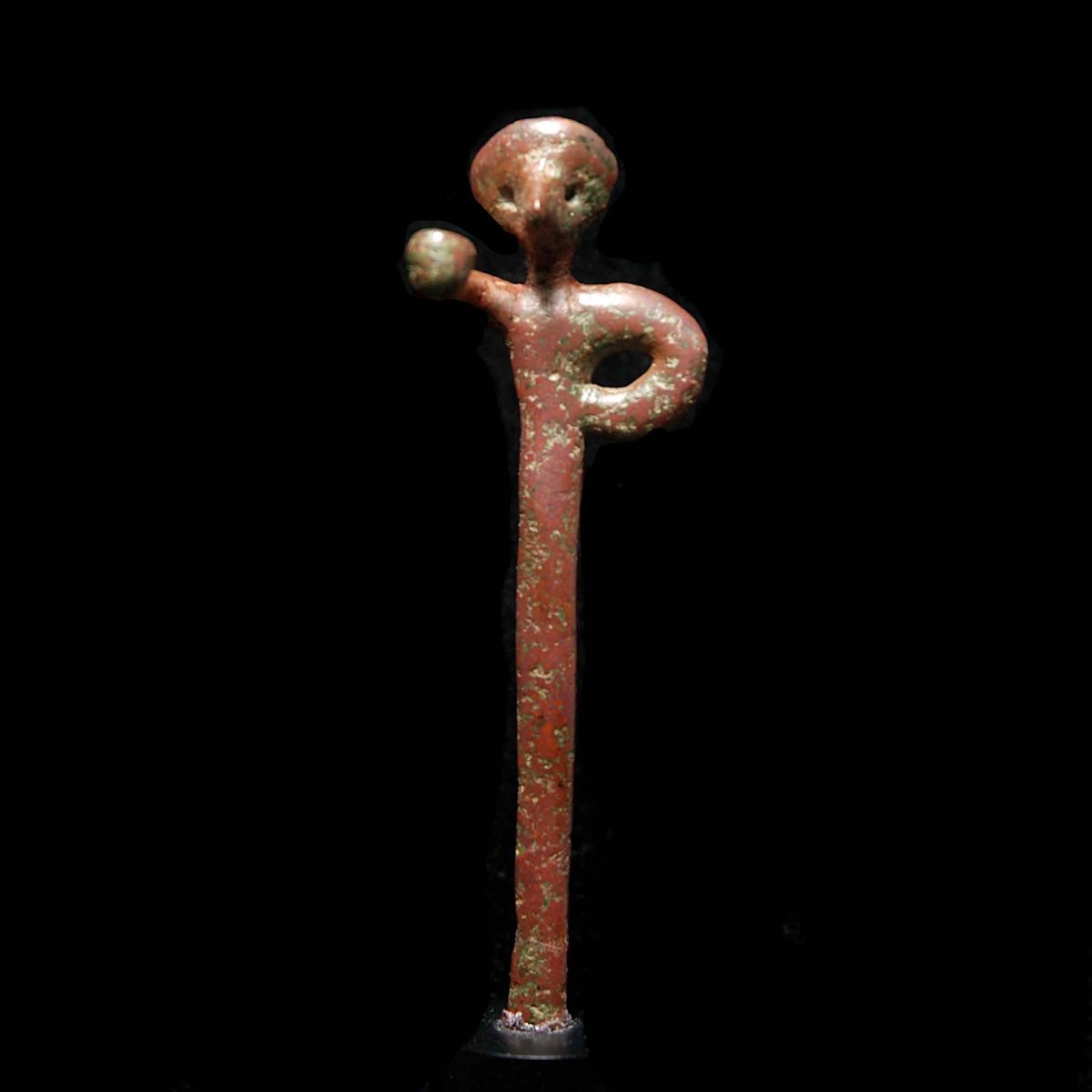
|
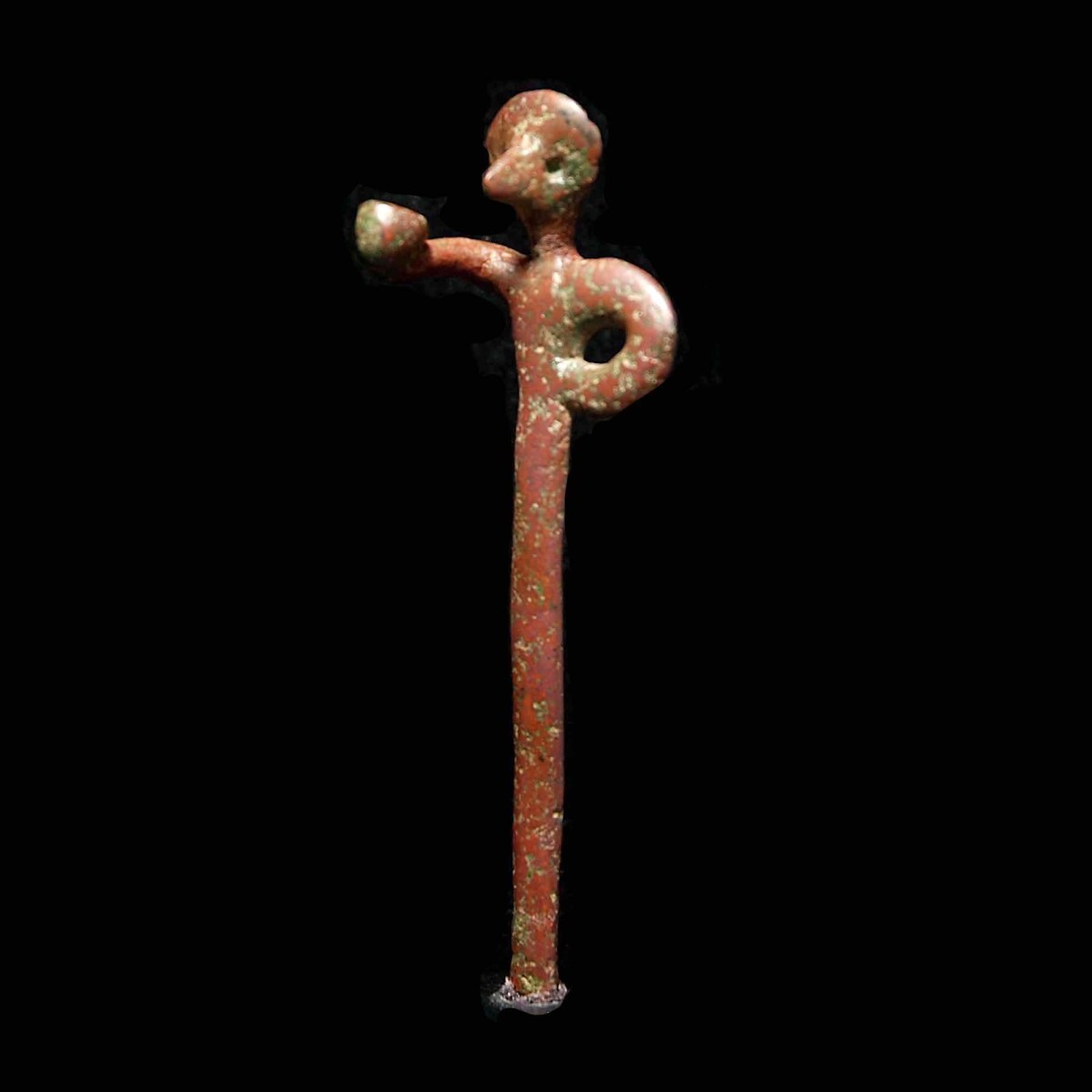
|
|
Hittite Empire – 1st half 2nd millennium B.C.
|
Highly stylized bronze idol with a rod-shaped, straight body. The legs are not accentuated. The head is round with deeply pierced eyes and a long bird nose. One hand is pressed against the hip, the other one clenched to a fist and stretched forward. Mounted.
|
Provenance: German private collection H. W., acquired prior to 1991.
Dimensions: 8 cm high
Price: 1 200 Euro
|
|
|
|
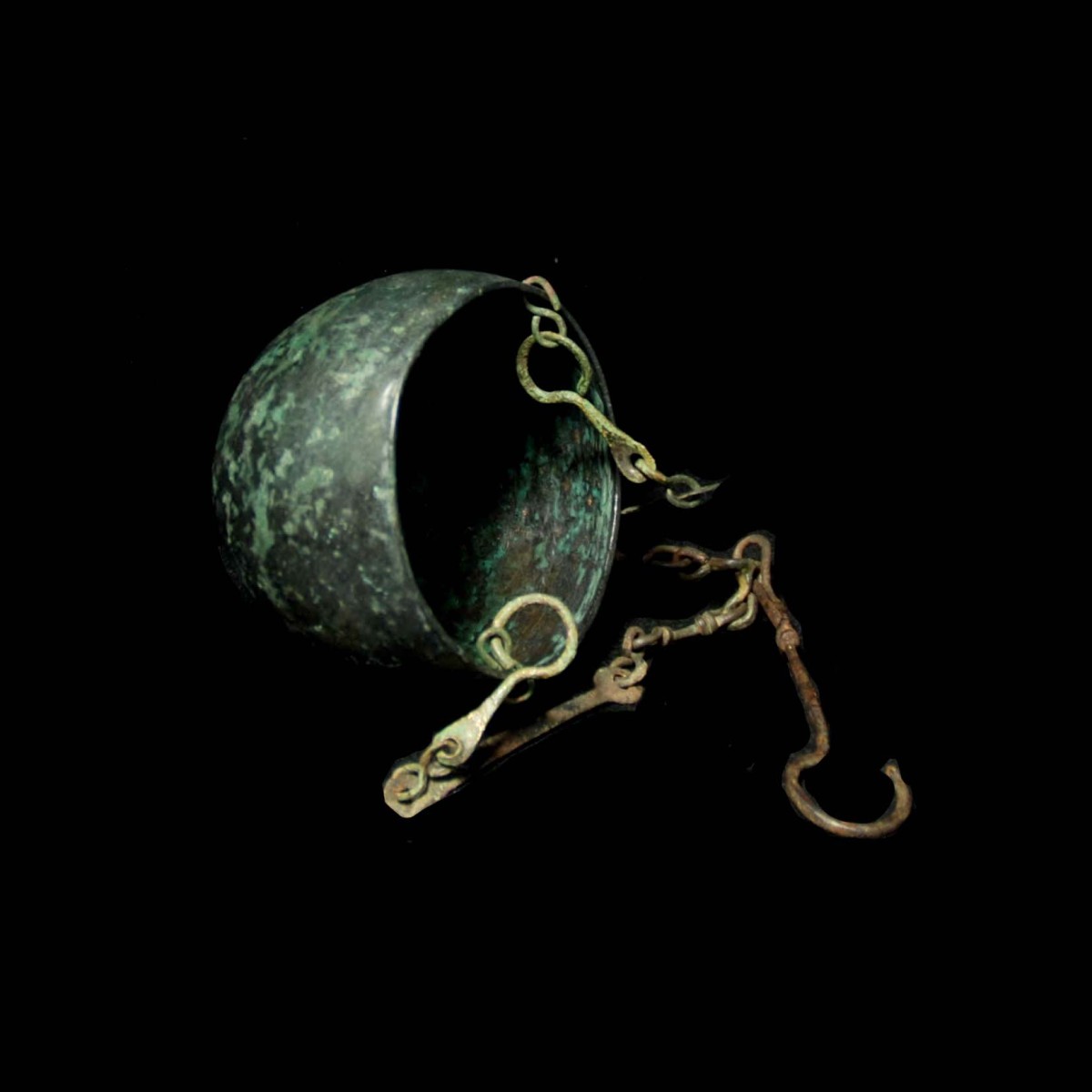
|
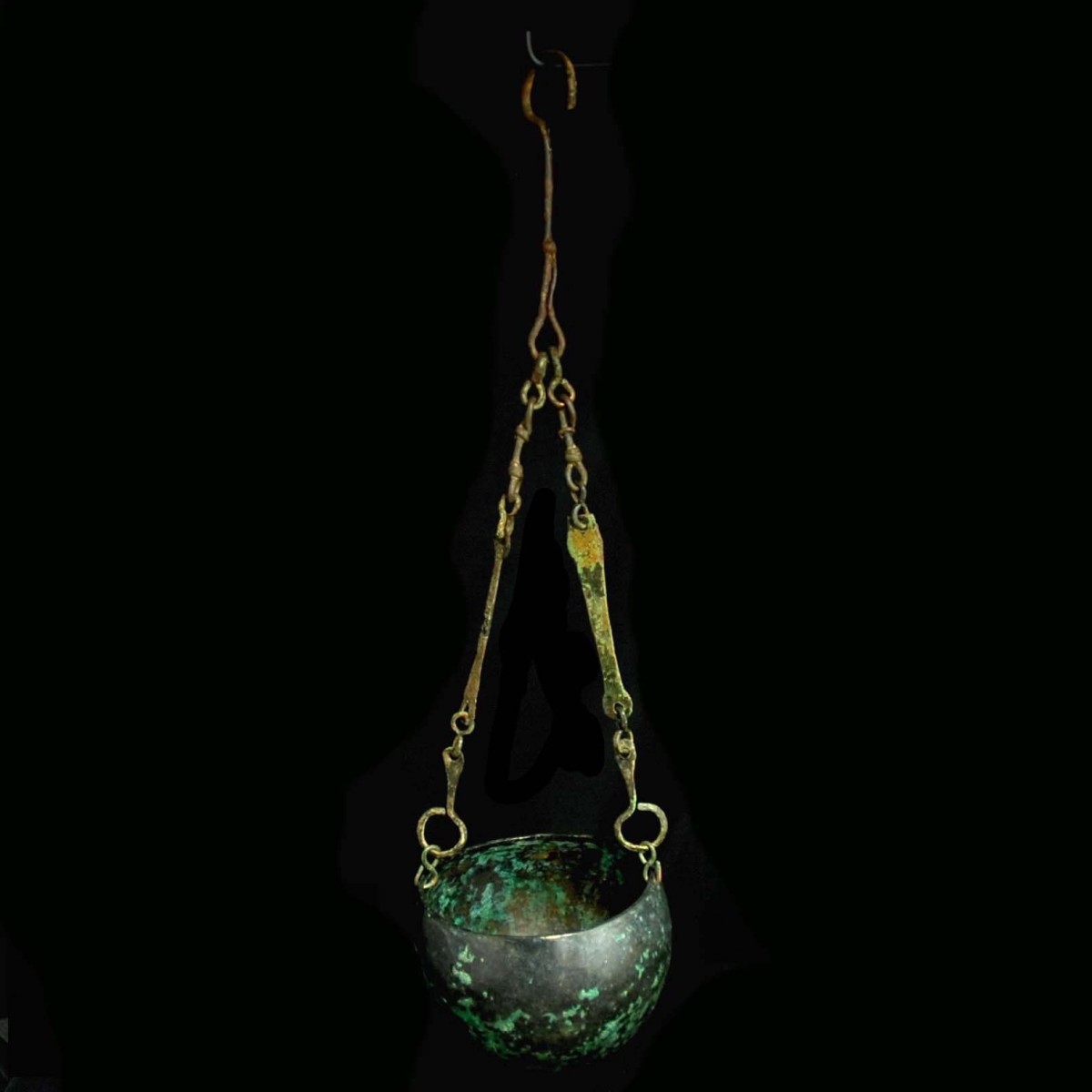
|
|
Byzantine Empire – 14th-15th century A.D.
|
The ovoid bronze bowl has a rounded bottom with a perforation where once possibly another pendant hung. Below the estuary two holes opposite each other where both chains, with almost the same length, were attached. Both chains meet in an eyelet, which ends as a large hook. Between the links ornamental sheets. Mounted.
|
Provenance: Southern German private collection prior to 1981. Thence Galerie Antiken-Kabinett Gackstätter, Frankfurt. With a certificate of Galerie Antiken-Kabinett Gackstätter, inventory number 05211.
Dimensions: 36 cm high (including chain); 10 cm in diameter (bowl)
Price: 900 Euro
|
|
|
|
|
|
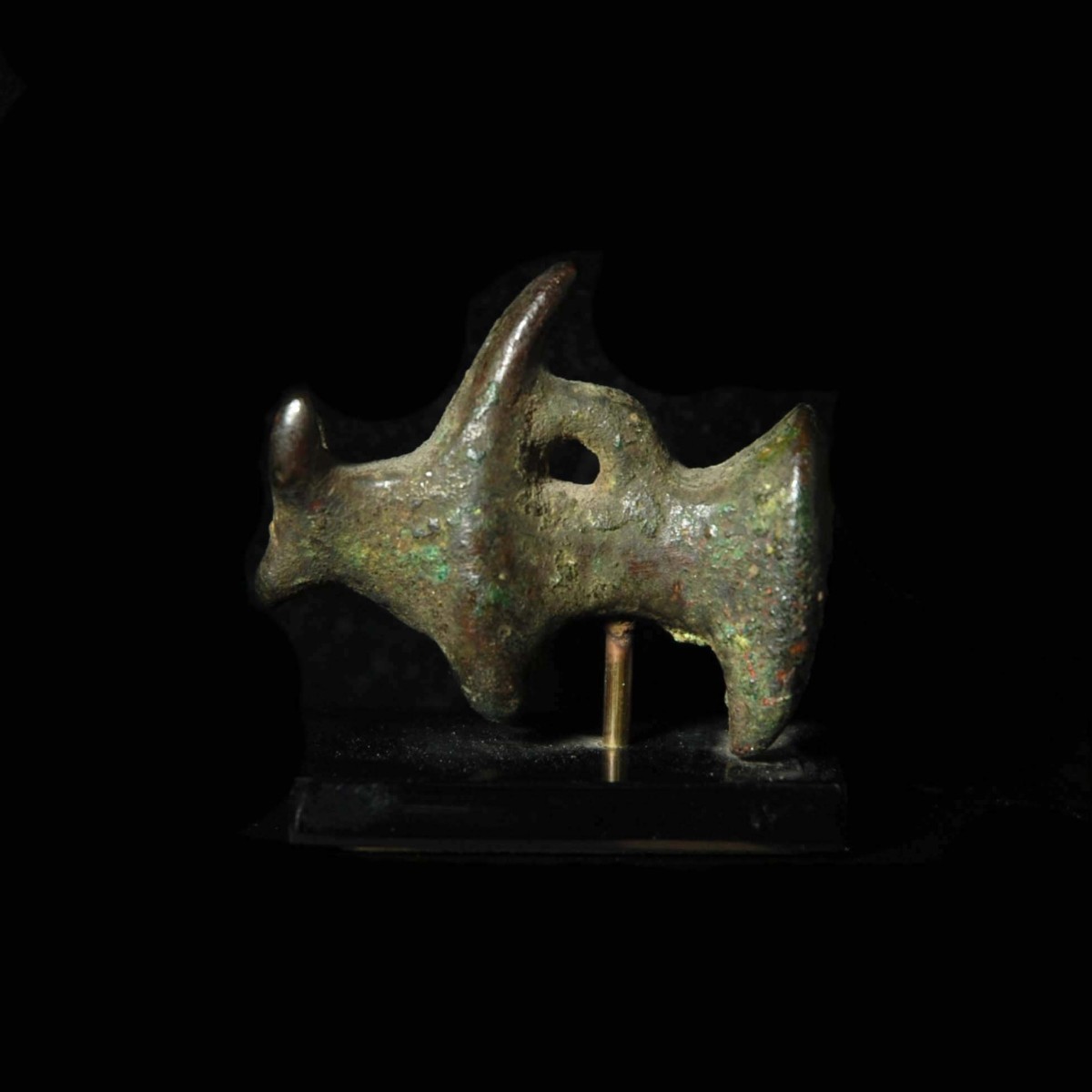
|
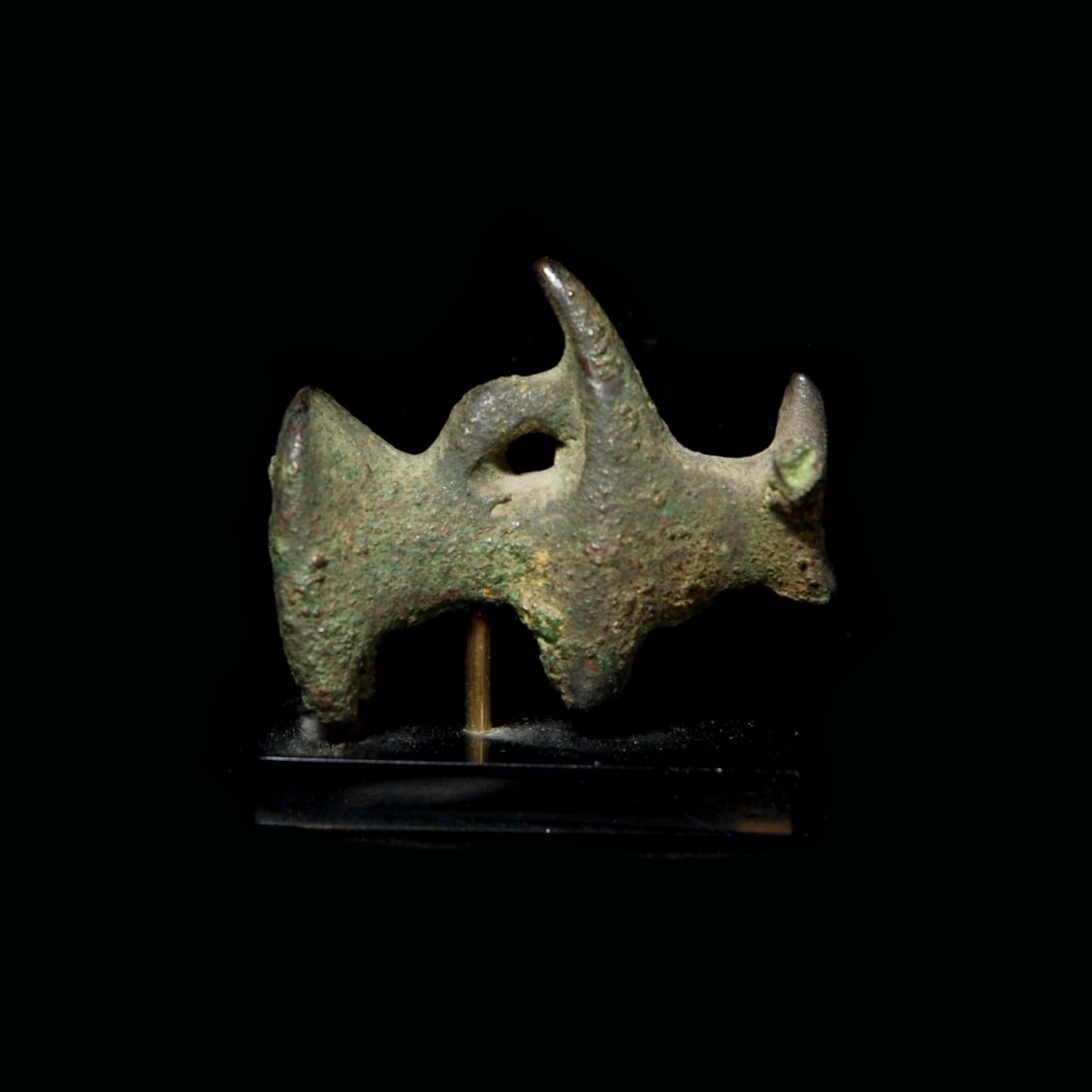
|
|
Iran/Amlash – 950-750 B.C.
|
Solid bronze amulet of a zebu from the Amlash culture. The animal with the typical circular and on the back flat buttock without a tail, as well as the steeply rising and tapering hump. The head with a strong neck, the legs short and stubby. On the back an eyelet for suspension. Mounted.
|
Provenance: From the collection of the French art critic and poet Max-Pol Fouchet (1913-1980). Thence in a family estate.
Dimensions: 4 cm long
Price: 900 Euro
|
|
|
|
|
|
|
|
Gesichter der Antike
|
Ihre mandelförmigen Augen strahlen geradezu über den hohen Backenknochen. Ihr Lächeln verzaubert uns noch nach 2.500 Jahren. Der wunderbare archaische Terrakottakopf einer Göttin ist sicher eines der schönsten antiken Gesichter, das wir derzeit im Programm haben. Wobei: Ein Lächeln schenkt uns auch der ägyptische Königliche – und das seit über 3.000 Jahren. Das Fragment eines Granitreliefs zeigt einen ramessidischen Noblen voll Stolz und Anmut. Doch Gesichter der Antike haben viele Facetten. Das beweisen das vogelgesichtige hethitische Stabidol und vor allem das kaukasische Idol eines Adoranten. Letzterer blickt uns mit großen Augen an und hebt seine riesigen Hände. Was wir heute als humoristischen Gestus empfinden könnten, stand einst für tiefe Ehrfurcht vor den Göttern.
|
24. März – Save the Date. Im März ist es nun endlich wieder soweit: Wir dürfen Sie am 24. März um 18.00 Uhr zu unserer ersten großen Ausstellungseröffnung des Jahres einladen. Unter dem Titel "Tierbilder aus Vier Jahrtausenden" zeigen wir Objekte von musealer Bedeutung. Wie diese aussehen, zeigt diese Einladung. Sie geht in den nächsten Tagen natürlich auch in Papierform in die Post. Genießen Sie mit uns einen weinseligen Abend und staunen Sie über Tierdarstellungen voller Kraft, Archaik, aber auch göttlicher Sanftheit. Wir freuen uns auf Ihr Kommen!
|
|
|
|
Unser Highlight des Monats:
|
|
Römisches Reich – 2. Jahrhundert n. Chr.
|
Qualitätsvoller Torso einer kräftigen, männlichen Figur, die ein gepunktetes Pantherfell trägt. Das Fell ist um den Bauch herum verschnürt und wird von der linken Schulter, auf der der Kopf des Tieres aufliegt, gehalten. Der Mann, als Satyr zu deuten, hält in seiner rechten Hand in Hüfthöhe einen Spieß mit zwei Vögeln, wohl Enten. Sein linker Arm verläuft parallel zum Körper, in der Hand hält er ein gejagtes Tier an den Beinen, wohl einen Hasen. Die Muskulatur und die Knochenstruktur sind detailreich gearbeitet. Ein wesensgleicher Torso, der sehr wahrscheinlich aus derselben Werkstatt stammt und derselben Figurengruppe zuzuordnen ist, befindet sich in der Barnes Foundation in Philadelphia, USA, unter der Accession Number A231. Der Barnes-Torso im gleichen gepunkteten Pantherfell hält einen Weinschlauch im Arm und wird ebenfalls als Satyr gedeutet. Es ist daher davon auszugehen, dass beide Statuen zu einer Figurengruppe gehörten, die mit Wein und Delikatessen zum dionysischen Feste schritt. Gesockelt.
|
Provenienz: Belgische Privatsammlung U.C., erworben in den 1950er Jahren. Seitdem in diplomatischen Familienbesitz.
Höhe: 46,5 cm
Price: 28.000 Euro
|
|
|
|
Ausgewählte Kunstwerke des Monats:
|
|
Ägypten – Naqada II-Kultur, 3500-3200 v. Chr.
|
Außerordentlich große, sehr elegante Vase der sogenannten Blacktop-Ware. Der ovoide, handgeformte Korpus verjüngt sich nach unten zu einer flachen Basis. Der Rand ist abgerundet und nach außen gestülpt. Der Ton wurde mit einem roten Eisenoxid überzogen, das nach dem Brennen die markante dunkelrote Farbe entwickelt. Der schwarze Rand entstand beim Brennen der Vase, als der obere Teil dem dichten Rauch ausgesetzt war. Vergleiche zum Typus mit abgerundetem, umgestülptem Rand und der konvexen Form die annähernd gleich große Vase im British Museum mit der Registration Number 1926,0728.6. Gesockelt.
|
Provenienz: Französische Privatsammlung Haumont, erworben zwischen 1980 und 2008. Verkauft am 14. Juli 2017 bei Drouot in Paris. Zuletzt im englischen Kunsthandel. Mit französischem Antikenpass.
Höhe: 35 cm
Preis: 12.000 Euro
|
|
|
|
|
Griechenland – um 500 v. Chr.
|
Überaus anmutiger Terrakottakopf einer Göttin aus spätarchaischer Zeit. Das ovale Gesicht mit hohen Backenknochen, gerader Nase, mandelförmigen Augen und dem typisch archaischen Lächeln. Die Ohren schmücken kugelförmige Ohrringe (einer fehlt). Sie trägt ein Haarband, das nur fragmentarisch erhalten ist, das Gesicht wird von Korkenzieherlocken gerahmt. Hals und rechter Schulteransatz sind noch erhalten. Am Sockel Etiketten mit Sammlungsnummern und ein Sticker mit der Aufschrift: „Greek Terracotta head of a Goddess“. Gesockelt.
|
Provenienz: New Yorker Privatsammlung. Danach versteigert bei Sotheby’s New York am 11. Dezember 2002, Los 77. Zuletzt in der US-Privatsammlung Dr. E. B.
Höhe: 18 cm
Preis: 8.000 Euro
|
|
|
|
|
Ägypten – Spätzeit, 30. Dynastie, 380-342 v. Chr.
|
Sehr fein gearbeitetes Uschebti aus dem Grab des Priesters Nesbanebdsched, das 1902 entdeckt wurde. Die mumienförmige Figur aus hellblauer Fayence mit vor der Brust überkreuzten Armen. In der linken Hand hält sie die Hacke, in der rechten den Handpflug sowie die geflochtene Kordel für das Saatgutsäckchen am Rücken. Das Uschebti steht auf einer trapezförmigen Sockelplatte und lehnt an einem Rückenpfeiler. Die Details des Gesichts sind fein ausgearbeitet, die Ohren schauen unter der dreigeteilten Perücke hervor, der Götterbart ist lang und geflochten, das Ende leicht eingerollt. Unter den verschränkten Armen setzt die T-förmige Hieroglyphen-Inschrift an. Die Übersetzung lautet: „Nesbanebdsched, geboren von Shentyt, der ‚imy-khenty‘ Priester, der Eine, der die zwei Götter trennt, der Priester des Osiris im Apet-Tempel, der Schreiber der Göttlichkeit, der Aufseher über die Wab-Priester der Sachmet in Hat-mehit (Mendes), der Priester der Banebdsched.“ Im Grab des Nesbanebdsched wurden 322 Uschebtis wie dieses mit T-förmiger Inschrift gefunden. Die meisten verblieben in Ägypten. Die übrigen befinden sich in Privatsammlungen und Museen. Siehe etwa das Uschebti im Metropolitan Museum of Art in New York mit der Accession Number 2021.41126 oder Sotheby’s Auktion vom 10. Dezember 2008, Los 4. Zur Literatur über die Uschebtis des Nesbanebdsched siehe J. F. Aubert and L. Aubert, "Statuettes égyptiennes, Chaouabtis, Ouchebtis", Paris, 1974, S. 125, "Reflets du divin: Antiquités pharaoniques et classiques d'une collection privée", Genf, 2001, Nr. 73c sowie G. Janes, "Shabtis: A Private View", Paris, 2002, Nr. 96. Gesockelt.
|
Provenienz: Schweizer Privatsammlung, erworben in den 1980er Jahren in der Galerie Faustus in Genf.
Höhe: 16,3 cm
Preis: 8.000 Euro
|
|
|
|
|
Ägypten – Neues Reich, 19. Dynastie, 1292-1189 v. Chr.
|
Fein gearbeiteter Reliefkopf mit dem Gesicht eines Mannes nach rechts. Die Augen mit fein gezogenen Lidern und kurzem Lidstrich. Der Mund zu einem sanften Lächeln geformt. Über den Brauen sind die Ansätze der Krone oder der Perücke erkennbar, die den Mann als Mitglied der königlichen Familie ausweisen. Wohl von einem Türsturz aus einem Heiligtum der Ramessidenzeit. Auf Metallsockel montiert.
|
Provenienz: Sammlung Carl Tautenhahn, Houston USA. Erworben vor 1982.
Höhe: 9,3 cm
Preis: 4.000 Euro
|
|
|
|
|
Mitteleuropa – Hallstatt B-Zeit, 1000-800 v. Chr.
|
Ein zusammengehöriges Paar aufwendig gearbeiteter Bronzezeit-Broschen oder Posamenteriefibeln mit jeweils acht kleinen und einer großen Endspirale. Mittelbügel, Endspirale und schlaufenförmiger Nadelhalter sowie die Nadel auf der Rückseite sind aus einem Bronzedraht geformt. Am Mittelbügel sind mittels drei Manschetten jeweils zwei parallel laufende Drähte befestigt, die auf jeder Seite zu jeweils vier Spiralen aufgedreht sind. Diese Art von Bronzezeit-Schmuck wurde vor allem auf dem Gebiet des heutigen Ungarn, der Slowakei und Tschechiens gefunden. Mit schöner schwarz-grüner Patina.
|
Provenienz: Sammlung Axel Guttmann (1944-2001). Danach amerikanische Privatsammlung Tom Barnett. Zuletzt in der Sammlung Rack in Deutschland.
Länge: 12,1 cm bzw. 12,4 cm
Preis: 4.800 Euro
|
|
|
|
|
Nord-Kaukasus – 1. Hälfte 1. Jahrtausend v. Chr.
|
Flaches Bronzeidol eines stilisierten Mannes im Adoranten-Gestus. Die unbekleidete Figur steht aufrecht mit leicht gespreizten Beinen und fast rechtwinkelig erhobenen Armen mit übergroßen Händen. Die Hände zeigen fünf Finger in Form von riesigen Zinken, der weggestreckte Daumen berührt dabei den Kopf. Das Gesicht mit großen, hervorquellenden, runden Augen, prägnanter Nase und tief gekerbtem Mund. Der Oberkörper und die Arme sind flach, Beine, Kopf und Geschlecht sind dagegen plastisch hervorgehoben. Votivfiguren wie diese wurden im Nordkaukasus, etwa in Karata in Dagestan gefunden. Sie wurden wohl als Gabe an die Götter nahe von Opferplätzen hergestellt, verkauft und den Göttern geopfert. Vergleiche zum Typus: „Archäologie und Volkskunst aus Dagestan: Völker zwischen Kaukasus und Kaspischem Meer: Katalog zur Ausstellung im Tiroler Volkskunstmuseum und im Vorarlberger Landesmuseum, 12. August bis 7. November 1999, 12. Februar bis 9. April 2000“, Nummer 50 und 51, Seite 58. Gesockelt.
|
Provenienz: Sammlung Dr. Wassilijew, 1980er Jahre. Danach Antikenkabinett Gackstätter mit der Inventarnummer 02808. Publiziert auf einer Weihnachtskarte des Antikenkabinetts Gackstätter Anfang der 2000er Jahre. Seit 2005 in einer Münchner Sammlung. Mit Original-Zertifikat des Antikenkabinetts Gackstätter und der Weihnachtskarte.
Höhe: 6,3 cm
Preis: 4.800 Euro
|
|
|
|
|
Römisches Reich – 22-23 n. Chr.
|
Prachtvoller Bronze-Sesterz der Kaiserin Livia, geprägt unter ihre Sohn Tiberius in der Münzstätte Rom. Auf der Vorderseite die Inschrift: S P Q R/IVLIAE AUGUST. Im Bild ein verziertes Carpentum (der überdachte zweirädrige römische Wagen), der innerhalb der Stadt Rom nur von wenigen, hochgestellten Damen, die zumeist auch Mitglied des Kaiserhauses waren, benutzt werden durfte. Vor dem Wagen sind zwei Maultiere gespannt. Auf der Rückseite SC für Senatus Consulto (Auf Beschluss des Senats) sowie umlaufend TI CAESAR DIVI AVG F AVGVUST P M TR POT XXIIII (für: Tiberius Caesar Divi Augusti Filius Augustus, Pontifex Maximus, Tribunicia Potestate Vicesima Quarta).
|
Provenienz: Auktion Conand Hotel d’Ainay, Lyon am 27. September 2018, Los 52. Davor in einer französischen Privatsammlung der 1960er bis 1970er Jahre.
Durchmesser: 3,6 cm; Gewicht: 27,45 Gramm
Preis: 3.200 Euro
|
|
|
|
|
Römisches Reich – 4. Jahrhundert n. Chr.
|
Römischer Becher aus durchsichtigem, entfärbtem Glas. Der Korpus mit zylindrischer, leicht konkaver Wand. Der flache Boden mit Heftnarbe aus der Wandung herausgearbeitet und massiv. Im oberen Teil des Bechers ein umlaufend aufgelegter Faden. Vergleiche zum Typus „Römisches, byzantinisches und frühmittelalterliches Glas – Sammlung Ernesto Wolf“, Hatje Cantz 2001, Nummer 109. Aus Palästina.
|
Provenienz: Aus dem Bestand der gerichtlich aufgelösten Pariser Galerie La Reine Margot. Dort mit der Inventarnummer 3791B gelistet.
Höhe: 10,5 cm
Preis: 1.200 Euro
|
|
|
|
|
Hethitisches Reich – 1. Hälfte 2. Jahrtausend v. Chr.
|
Stark stilisiertes Bronze-Idol mit stabförmigem, geradem Körper. Die Beine sind nicht akzentuiert. Der Kopf ist rund mit tief eingestochenen Augen und langer Vogelnase. Eine Hand ist in die Hüfte gestemmt, die andere zur Faust geballt und nach vorne gestreckt. Gesockelt.
|
Provenienz: Deutsche Privatsammlung H. W., erworben vor 1991.
Höhe: 8 cm
Preis: 1.200 Euro
|
|
|
|
|
Byzantinisches Reich – 14.-15. Jahrhundert n. Chr.
|
Die ovoide Bronzeschale hat einen gerundeten Boden mit einem Loch, in dem wohl einst weiterer Anhänger hing. Unterhalb der Mündung sind gegenüberliegend zwei Löcher eingestochen, in denen die beiden etwa gleich langen Ketten befestigt sind. Oben treffen sich die Ketten in einer Öse, die als großer Haken endet. Zwischen den Kettengliedern Zierbleche. Gesockelt.
|
Provenienz: Süddeutsche Privatsammlung vor 1981. Danach Galerie Antiken-Kabinett Gackstätter, Frankfurt. Mit Zertifikat der Galerie Antiken-Kabinett Gackstätter, Inventarnummer 05211.
Höhe mit Kette: 36 cm; Durchmesser Schale: 10 cm
Preis: 900 Euro
|
|
|
|
|
Iran/Amlash – 950-750 v. Chr.
|
Vollbronze-Amulett eines Buckelrinds aus der Amlash-Kultur. Das Tier mit dem typisch kreisrunden und rückseitig flachen Gesäß ohne Schwanz sowie dem steil aufragenden und spitz zulaufenden Buckel. Der Kopf mit kräftigem Hals, die Beine kurz und stummelig. Am Rücken eine Öse zur Aufhängung. Gesockelt.
|
Provenienz: Aus der Sammlung des französischen Kunstkritikers und Schriftstellers Max-Pol Fouchet (1913-1980). Seitdem in Familienbesitz.
Länge: 4 cm
Preis: 900 Euro
|
|
|
|
|
|
|
CHRISTOPH BACHER ARCHÄOLOGIE ANCIENT ART GmbH
|
Galerie: Stubenring 20, A-1010 Wien
Showroom: Untere Viaduktgasse 55, A-1030 Wien
|
|
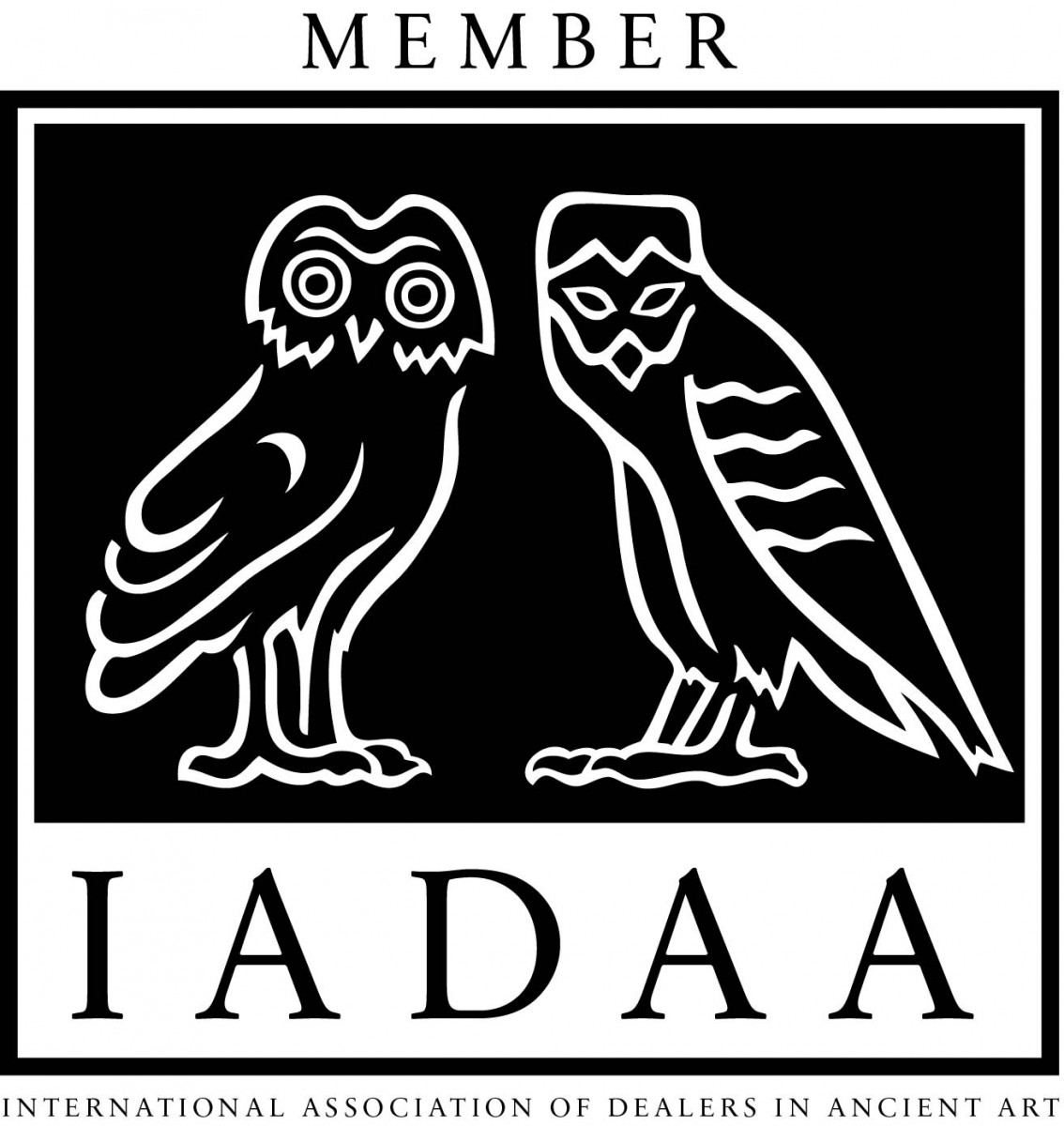
|
|
|
|